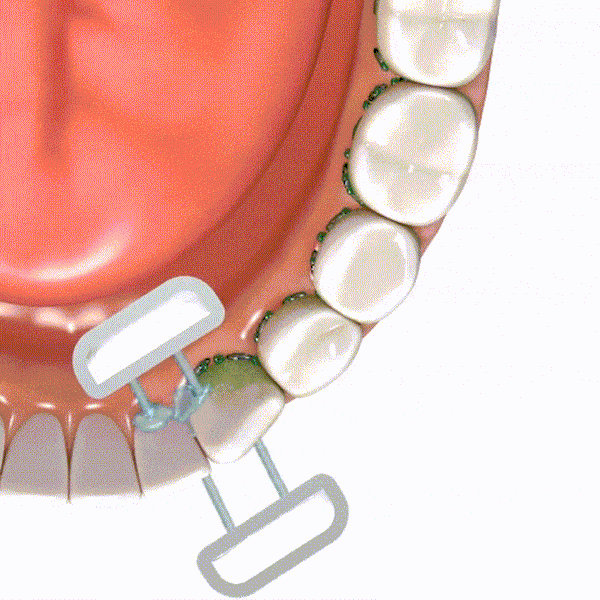Before we had the idea to create Instafloss, we searched far and wide for an automatic flosser. Because string was painful and tedious, we often found ourselves neglecting to floss (much to the detriment of our oral health). Between the constant urging of dentists and a fear of cavities, something had to change.
We hoped to find something that would solve the problem of an uncomfortable, time consuming floss – something that was quick, painless, and effective. While we weren’t quite able to find exactly what we were looking for, we did find some creative takes on how to handle that aspect of the oral hygiene routine.
One example is the GUM® FLOSBRUSH Automatic. Although it doesn’t floss your teeth for you, it is an automatic dental floss dispenser. It’s shaped like a toothbrush, but instead of bristles at the end there is a piece of floss wound between two prongs. Pressing a lever on the handle switches in new, fresh floss to use.

A fresh start
If one is using string to floss, it’s important to make sure that a clean piece of string is used for each tooth so as not to simply redistribute bacteria or food particles from one part of the mouth to another. It’s recommended that you cut an 18 inch long piece of dental floss to be able to continually wrap the floss around your finger as you go, ensuring a clean segment flosses each tooth.
This is why many take issue with certain small gum flossers, such as floss picks. Although they are convenient, there is simply too short of a string to get the cleanest, best possible floss for each tooth.
The GUM® FLOSBRUSH Automatic aims to solve this problem, being shaped similarly to a floss pick, but with an automated floss replenishment. It’s roughly as portable as a disposable pick, but has the benefits of being more hygienic, and reusable.
It comes with a cap for when it's not in use, which makes it suitable for keeping in your bag or car. One downside of this product is that there isn’t a way to replace the floss – it seems you have to either buy a new one when you run out or wash and reuse the string. This defeats the purpose of a tool that is supposed to dispense clean floss for each use, and is more wasteful.
How does the GUM FLOSBRUSH Automatic compare to Instafloss?
Despite the name, the GUM® FLOSBRUSH Automatic is not an automatic flosser. You still need to floss each tooth individually, taking the time to switch out the string between each tooth. This can take upwards of two minutes, vs just 10 seconds with Instafloss.
The discomfort of using string to floss is an obstacle for many – some don’t floss because of the pain and gingival bleeding it can cause. That aspect is still present with the GUM® FLOSBRUSH Automatic, as it uses string as its mechanism to clean between the teeth and under the gumline. 
In contrast, Instafloss uses adjustable pressure pulsing water jets to floss. Water flossing is a less painful and more effective alternative that people have been using for over 60 years. The difference between the past 60 years of water flossing and Instafloss is that Instafloss provides an automated floss complete in just 10 seconds. With Instafloss, you no longer need to aim yourself (improper technique is very common, and provides a less effective floss), trace each tooth individually, or - best of all - take two minutes to do it.

String vs water
We went into great detail comparing string flossing to water flossing in our previous blog titled “Water Flossing vs String Flossing: What Does the Science Say?" (worth a read if you haven’t seen it yet!), but some key points include:
- Water flossing is 129% as effective at removing plaque as string (Goyal CR, et al.)
- Water flossing is 151% as effective at reducing instances of gingivitis (Barnes CM, et al.)
- Water flossing is 200% as effective at reducing gingival bleeding (Rosema NAM, et al.)
- Water flossing can remove up to 99.9% of biofilm, as revealed by using scanning electron microscopy (Gorur, et al.)
- Water flossing is able to disrupt bacteria up to 6mm deep into the periodontal pockets, as opposed to 3mm for string (Drisko, et al.)
- Water flossing can reduce the depths of periodontal pockets in as little as two weeks (Cutler, et al.)
There are other benefits besides the increased efficacy detailed above – many are discouraged from using string because it’s uncomfortable or downright painful, can cause bleeding, or is difficult to maneuver with orthodontic appliances, like braces. Water flossing provides an alternative solution to string in each of these regards.
Do I want an automatic flosser?
Given that the Instafloss mouthpiece is a combination of several jets (to allow for coverage of multiple teeth at once, reducing the floss time to 10 seconds) one question we often get asked about Instafloss is, “but don’t you want to be able to point the jet stream directly into your gums?”
With a single jet water flosser, one is able to control the angle of the stream used to floss. This is not possible with our mouthpiece, and the question is raised whether this reduces the efficacy. Many people have the instinctive assumption that pointing the jet into the gum (at a 45 degree angle) would yield a more effective clean. If so, the fact that it’s a time saving, automatic flosser doesn’t quite matter as much – you can save all the time by not flossing at all.
This assumption makes intuitive sense, but isn’t the case.
The most effective angle for a water floss is a topic that has been studied and published by both Eakle, et al. in 1986 and Selting, et al. in 1972. They hypothesized that a 45 degree angle would penetrate deeper beneath the gumline than a 90 degree angle (which would make intuitive sense, seems like a better angle of attack), but the data do not support this conclusion.
The 90 degree angle did better than the 45 degree angle, contrary to their initial supposition. Looking at facial and lingual data, the 90 degree angle cleaned, on average, over 50% deeper than the 45 degree angle. For people with moderate pockets (4-7 mm) both angles were about equally effective. Selting tested the difference between pointing the irrigator tip perpendicular and parallel to the long axis of the tooth and found no significant difference. These studies indicate that a 90 degree angle is at least as good as a 45 degree angle -- it's the same for moderate pocket groups and better for low- or deep-pocket groups.
Some flossing is better than no flossing
Whether you’re using the latest, highest tech automatic flosser on the market, or the age-old string, one thing remains true: it’s better to use either (or anything in between) than nothing at all.
If you brush, but never floss, you can leave as much as 35% of your tooth’s surface uncleaned! Doing so will negatively affect your oral health, with possible effects on seemingly unrelated areas of health. It may not surprise you that neglecting to floss may lead to cavities, gum disease, tooth decay, or gum recession, but oral health has also been linked to diabetes, heart disease, alzheimers, arthritis, and even erectile dysfunction.
Ideally, one should floss every day. In actuality, very few people do – 70% of Americans don’t. Flossing every other day or even just 2-3 times per week would greatly improve one’s oral health.
If having something you can keep in your car will make it easier and more likely for you to floss after eating at a restaurant, then it’s absolutely worth it. It may not be an automatic flosser, it may not be the most effective flosser, it may not even be designed as well as it could be, but it will improve your health.
Summary
The GUM® FLOSBRUSH Automatic and Instafloss are two very different devices. We wanted to get more people to floss by making it quick, comfortable, and effective. By removing these obstacles, ensuring a thorough and complete oral care routine is much more achievable.
However, any flossing is better than no flossing, and being able to floss each tooth with a fresh piece of string is preferable to using the same piece over and over. Instafloss is not portable – if you’re looking for something small and handy to keep in your car for a quick post-lunch floss, the GUM® FLOSBRUSH Automatic is not a bad option.
For your bathroom at home, where you have counter space for a more permanent device, the benefits of being an automatic flosser that is quick, effective, and easy to use outweigh portability. After all, if you can be sure to get a complete floss so quickly and easily that you’d never forget to include it in your routine, why not take advantage of it?



2 comments
Progress update, please?
———
Instafloss replied:
Hello Deborah,
We’ve continued to post a progress update each month since the posting of this blog :)
All updates can be read here on our site, with October’s being the latest: https://instafloss.com/blogs/news/october-manufacturing-update-pilot-product-run-progress
With Smiles, The Instafloss Team
Good Morning
Like many others, I placed my instafloss order in June 2021. The completed product has me incredibly excited. The warranty is the only issue I have. Everyone who receives the instafloss will utilize it before anyone else does. Of course, there is a possibility of flaws. Given that this is an expensive piece of equipment, will there be coverage for replacement?
———
Instafloss replied:
Hello Contina,
We are doing extensive testing to make sure Instafloss is as durable and effective as possible. As was the subject of some previous updates, our commitment to quality has been the cause of some delay – we’d much prefer to take the time necessary to deliver a product you’ll love than rush something that doesn’t work as promised or is poorly built.
That being said, we know that in the reality of working at this scale, some units may come out of the factory with defects, or a particularly rough shipping experience may dislodge something. If this occurs, we take the responsibility of fixing it. All pre-orders come with the extended two year warranty – those who order Instafloss after delivery will receive a one year warranty.
With Smiles, The Instafloss Team